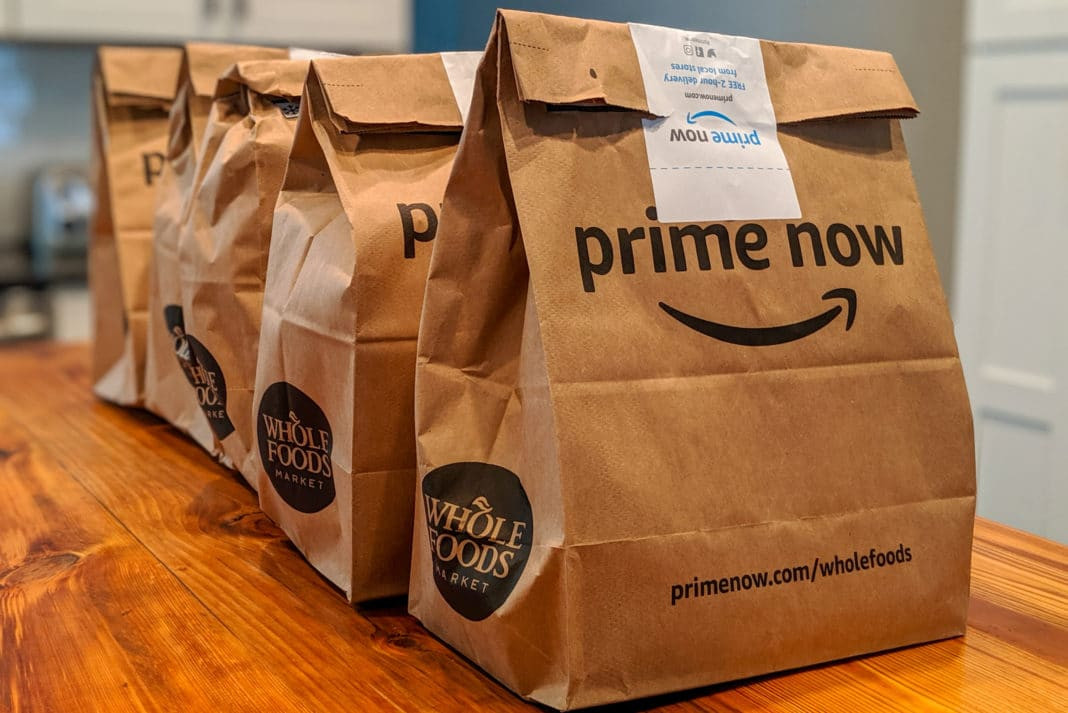
Relive the story of how Whole Foods became Amazon’s grocery store brand
When Whole Foods first launched with a dedication to organic food, fair trade, and quality prices, no one would imagine it would be swallowed by Jeff Bezos. Bezos’s company, once known for selling college textbooks online, is now the place where Americans have been sad-buying cheap, plastic crap they don’t need during the pandemic, and is only behind Wal-Mart when people bring up corporate greed.
So how did a company that billed itself on quality, fairness, and swallowing a good chunk of change for its goods (hence its old moniker “Whole Paycheck”) become Amazon’s brand? Let’s take a trip back to 2017 and revisit Amazon’s acquisition – one which financial experts have claimed has changed groceries forever.

Humble beginnings
According to its site, Whole Foods was founded by four business people in Texas who wanted to take organic food to the supermarket. John Mackey & Renee Lawson Hardy from Safer Way Natural Foods and Craig Weller & Mark Skiles of Clarksville Natural Grocery decided to join forces and create Whole Foods in 1980. It grew slowly over the next few decades to become the king of organic food grocers and a household name.
However, while Whole Foods cornered the market in organic food & specialty products in the 2000s, other retailers caught up. The 2010s saw the company begin to struggle. NBC reported that not only were well-known supermarkets beginning to offer more affordable organic produce like Wal-Mart, but “nontraditional players” like German grocery store Lidl were expanding, adding to Whole Food’s competition.
Thus, the organic grocery store chain began to flounder. Then, an investment firm came along, saying Whole Foods “shares are undervalued and represent an attractive investment opportunity”. Soon, they became the second-biggest owner of Whole Foods shares.

Jana Partners
The push into Amazon’s arms was spurred on by activist hedge fund Jana Partners, who owned nearly 10% of Whole Food’s stock. Jana stood to make $300 million from the acquisition, prompting Whole Foods’ co-founder & CEO John Mackey to call the hedge fund “greedy b******s” per Reuters. Jana also stood to make over $1 billion in stock from the sale.
Jana pressured Whole Foods to adopt better practices, including “adding directors with experience in retail, technology, finance, and real estate” per Reuters. The motive was reportedly to make Amazon more competitive. Mackey claimed Whole Foods was “getting better”, and Jana’s motives had nothing to do with improving the company. Rather, it had to do with Jana’s wish to profit off Whole Foods’ sale to Amazon.
“But these guys just want to sell us because they think they can make forty or fifty percent in a short period of time. They’re greedy b******s, and they’re putting a bunch of propaganda out there, trying to destroy my reputation and the reputation of Whole Foods because it’s in their self-interest to do so”, Mackey said in an interview with Texas Monthly.

How did Amazon’s acquisition of Whole Foods change the game?
Two words: Amazon Prime. Prime customers can see when Whole Foods organic blueberries or specialty organic shampoo is on sale & available for Amazon’s two-day delivery. Amazon actually offers two-hour delivery for its groceries for Prime members. If you’re a Prime member, organic food can be yours in record time from Amazon’s grocery store.
The “prime effect” caused other grocery stores to offer similar deals. Wal-Mart offered free grocery delivery at $98 per year. Meijer, a Midwestern grocery chain, offers scheduled grocery deliveries with a $9.95 surcharge and has partnered with Shipt to make it happen.
Another change was the erosion of Amazon’s relationship with Instacart. While this was seen as a potential blow to Instacart, Forbes noted it was actually beneficial for Instacart, as the defunct partnership freed up the grocery delivery service to work with more competitors.

Any downsides?
Here’s where the labor changes Amazon has reportedly enacted at its new grocery store come in. Forbes noted Amazon has centralized Whole Foods’ operations, moving HQ completely to Texas and eliminating more localized positions like an in-house graphic designer who would write weekly specials on a chalkboard, or weekly story hour for kids.
Amazon reportedly cut break time and other perks for their grocery store employees. They cut breaks down from fifteen minutes to ten minutes per Vice News. They also reportedly cut part-timers’ healthcare benefits, eliminated gainsharing, and introduced shift cuts after the minimum wage was raised to $15 per hour in the grocery store.

Amazon has also stamped their blue & yellow brand all over the previously green grocery store. One Whole Foods worker in California told The Guardian: “It sends chills down my spine every day to see the store I love bombarded with everything and anything Amazon, from the Prime signs, Amazon lockers, Amazon meal kits and the Prime shoppers.”
Further, Amazon delivery drivers alleged unsafe working conditions at the beginning of the pandemic, calling for a “sickout” last year to demand hazard pay and paid sick leave. While Amazon & Whole Foods released statements about their dedication to their employee’s safety, some employees alleged it was more for show to keep customers. “I’m resigned to the fact that most of us are going to get sick”, one employee said.







